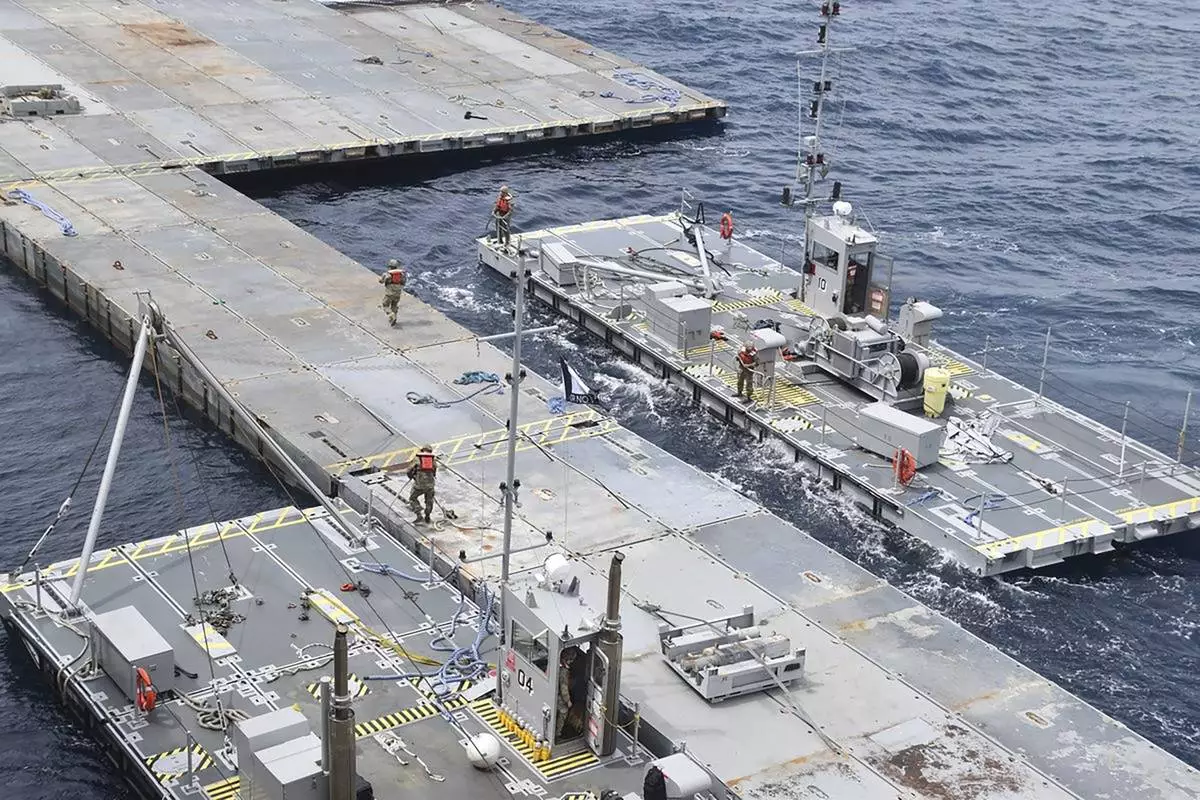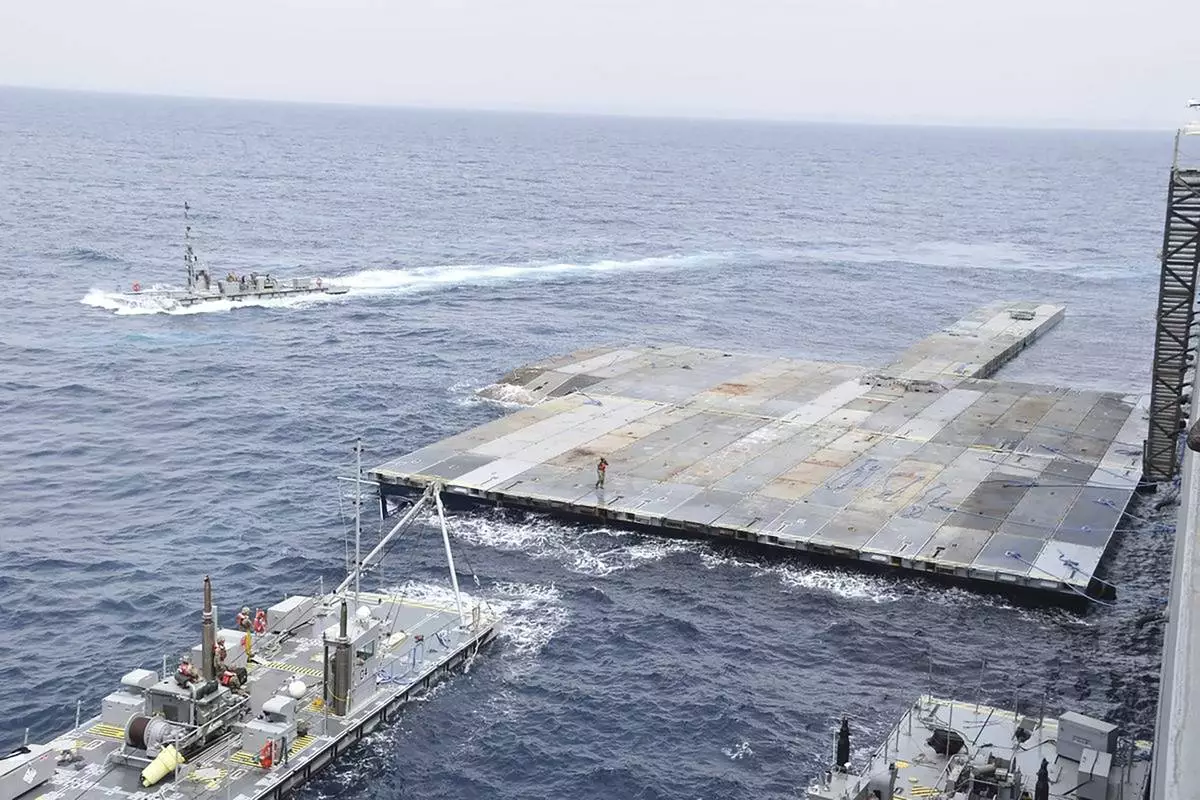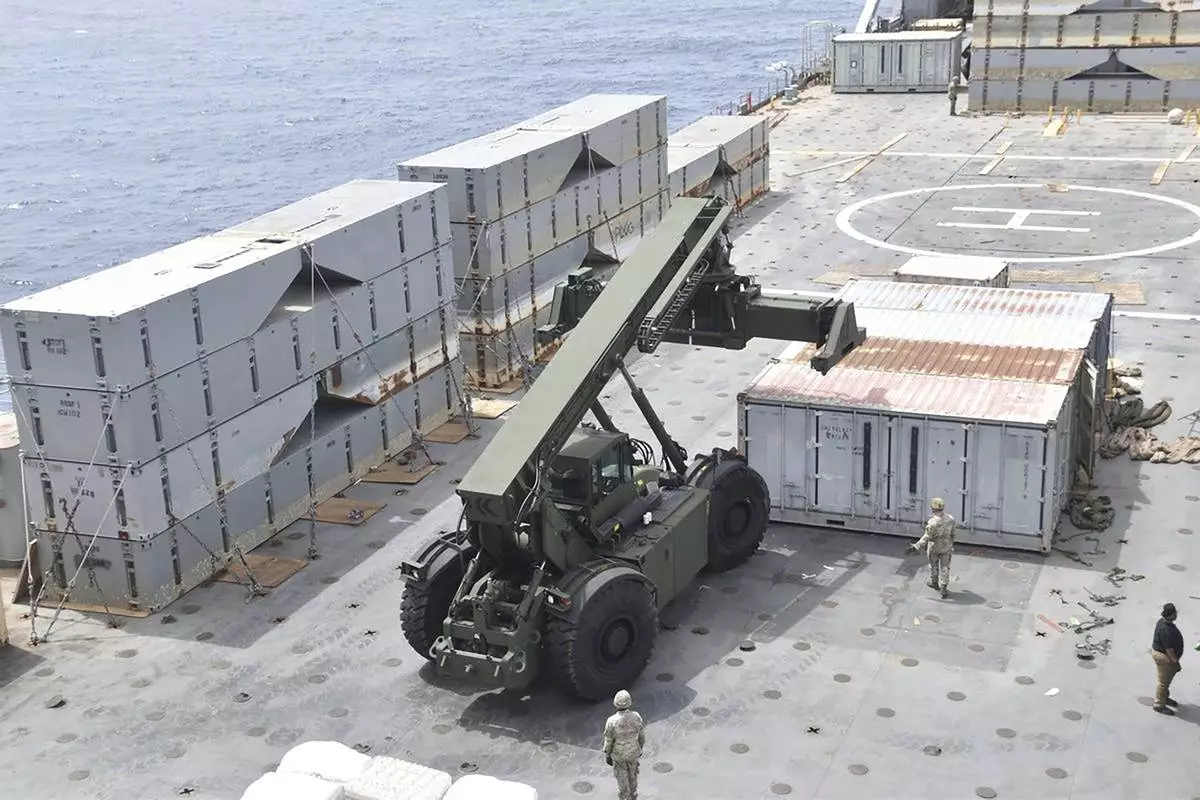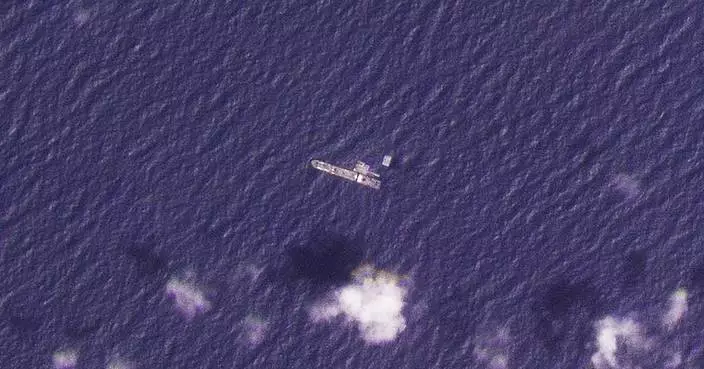Some advice to all the parents out there, particularly those swept up in the soaring passion and tear-jerking emotion of the Olympics.
If your children dream of going for a gold medal someday, you might want to nudge them in a different direction.

In this June 24, 2016, file photo, Chuck Wielgus, executive director of USA Swimming, answers a reporter's question during a news conference at the U.S. Olympic team trials in Omaha, Neb. USA Swimming and longtime executive director Wielgus, who apologized to victims of sexual abuse, maintained control over the day-to-day operations right up until his death in April from colon cancer. (AP Photo/Orlin Wagner, File)
At the very least, it's time to have a serious talk about the very real dangers they could face along the way.
Because this much is clear: The folks who run the U.S. Olympic movement have largely failed when it comes to protecting our young athletes from predators and perverts, and there's not much reason to believe this intolerable situation will improve without a total shake-up.
Right in the midst of the Winter Games, with hardly enough time for Larry Nassar to settle into the prison cell where he'll be spending the rest of his life, we got another report detailing horrific abuse and shameful cover-ups within one of the most high-profile summer sports.

In this Feb. 5, 2018, file photo, Larry Nassar listens during his sentencing at Eaton County Circuit Court in Charlotte, Mich. Right in the midst of the Pyeongchang Games, with hardly enough time for Larry Nassar to settle into the prison cell where he'll be spending the rest of his life, we got another report detailing horrific abuse and shameful cover-ups within one of the most high-profile summer sports. (Cory Morse/The Grand Rapids Press via AP, File)
The Southern California News Group conducted an extensive investigation that found USA Swimming repeatedly balked at overhauling a culture in which "the sexual abuse of underage swimmers by their coaches and others in positions of power within the sport was commonplace and even accepted by top officials and coaches," resulting in hundreds of young victims.
If all that sounds familiar, it should.
This issue has been a stain on swimming for years now, rearing its ugly head again recently when 2012 Olympian Ariana Kukors accused former coach Sean Hutchison of grooming her beginning at the age of 13 for what became an underage sexual relationship. Hutchison denied the claims.
Of course, we're still trying to process how hundreds of young gymnasts could be molested by Nassar under the guise of medical care, while USA Gymnastics largely looked the other way. Thankfully, the disgraced sports doctor has been locked away for good, but the long list of victims — including several gold medalists — are left to cope with their own life sentences.
"The Olympic system failed you, and we are so incredibly sorry," U.S. Olympic Committee chairman Larry Probst said shortly before the flame was lit in Pyeongchang.
To its credit, the USOC has taken some positive steps.
It launched the U.S. Center for SafeSport, which is responsible for investigating all abuse cases involving Olympic athletes.
It forced out the leadership at USA Gymnastics.
"We think that we did what we were supposed to do," Probst said. "Could we have done more? Of course. You can always do more."
Indeed, the USOC could've done more, should've done more.
Yet with each passing day, it becomes more and more difficult to believe that those currently in charge are capable of such a monumental change in action and attitude.
The latest report certainly raises new questions about the USOC failing to take any meaningful steps against USA Swimming and longtime executive director Chuck Wielgus , who maintained control over the day-to-day operations right up until his death in April from cancer.
Speedskating dealt with its own sexual abuse scandal a few years ago . Andy Gabel, a four-time U.S. Olympian in short track, was accused of having improper sexual relationships with two underage skaters, leading to his resignation from leadership positions within both the U.S. and international governing bodies.
Incredibly, though, Gabel remains a member of the National Speedskating Hall of Fame.
That is yet another slap in the face to those who have suffered, and another unmistakable sign that those in power refuse to comprehend the depth of the problem — or just don't care.
The USOC stands at the top of a complex web, but it has always been hesitant about reining in the more than 40 sports organizations it oversees, known as national governing bodies (NGBs).
That has led to a baffling range of policies for dealing with emotional, physical and sexual abuse, almost certainly guaranteeing that the next scandal is right around the corner.
If it can happen in swimming and gymnastics, just imagine how easy it would be for a sexual predator lurking in a lower-profile sport to wreak untold misery.
Probst acknowledged that the hands-off approach to the NGBs must change.
"Right now, they are independent institutions that have their own board of directors, their own management teams, their own revenue-generating machines," he said. "But clearly some things have occurred that would indicate we need to have a different relationship than we may have had in the past."
Of course, one must wonder why it took so long to recognize such an obvious flaw in the system.
It's easy to see the reasoning of those who want the USOC to clean house, a demand being pushed by two U.S. senators and former Olympic swimmer and activist Nancy Hogshead-Makar, whose group includes 17 other Olympians.
In particular, they have a bulls-eye on CEO Scott Blackmun.
"We've done a lot of things," Probst said while defending Blackmun, "but clearly more needs to be done."
In the meantime, parents, you might want to put a damper on your kids' Olympic dreams.
Their safety comes first.
WASHINGTON (AP) — The U.S. and allies are scrambling to pull together a complex system that will move tons of humanitarian aid into Gaza by sea. Nearly two months after President Joe Biden gave the order, U.S. Army and Navy troops are assembling a large floating platform several miles off the Gaza coast that will be the launching pad for deliveries.
But any eventual aid distribution — which could start as soon as early May — will rely on a complicated logistical and security plan with many moving parts and details that are not yet finalized.
The relief is desperately needed, with the U.N. saying people in Gaza are on the brink of famine. But there are still widespread security concerns. And some aid groups say that with so much more needed, the focus should instead be on pushing Israel to ease obstacles to the delivery of aid on land routes.
Setting up the system is expected to cost at least $320 million, the Pentagon said Monday. Here's how it will work:
Humanitarian aid bound for Gaza through the maritime route will be delivered by air or sea to Cyprus, an island at the eastern edge of the Mediterranean Sea.
Cyprus Foreign Minister Constantinos Kombos has said the aid will undergo security checks at Larnaca port. Using that one departure point will address Israel's security concerns that all cargo be inspected to ensure that nothing is loaded on ships that Hamas could use against Israeli troops.
The screening will be strict and comprehensive, including the use of mobile X-ray machines, according to a Cyprus government official who spoke on condition of anonymity to publicly disclose details about the security operation. The process will involve Cypriot customs, Israeli teams, the U.S. and the United Nations Office for Project Services.
An American military official said the U.S. has set up a coordination cell in Cyprus to work with the government there, the U.S. Agency for International Development and other agencies and partners. The group will focus on coordinating the collection and inspection of the aid, said the official, who also spoke on condition of anonymity to discuss operation details.
Once the pallets of aid are inspected, they will be loaded onto ships — mainly commercial vessels — and taken about 200 miles to the large floating pier being built by the U.S. military off the Gaza coast.
There, the pallets will be transferred onto trucks that in turn will be loaded onto two types of smaller Army boats — Logistic Support Vessels, or LSVs, and Landing Craft Utility boats, LCUs. The U.S. military official said the LSVs can hold 15 trucks each and the LCUs about five.
The Army boats will then shuttle the trucks from the pier to a floating causeway, which will be several miles away and anchored into the beach by Israeli Defense Forces.
Since Biden has made clear that no U.S. forces will step foot in Gaza, the troops doing the construction and driving and crewing the boats will be housed and fed on other ships offshore near the large floating pier.
The British Royal Navy support ship RFA Cardigan Bay will provide accommodations for hundreds of U.S. sailors and soldiers working to establish the pier. Another contracted ship will also be used for housing, but officials did not identify it.
The small Army boats will sail to the two-lane, 550-meter (1,800-foot) causeway.
The U.S. military official said an American Army engineering unit has teamed up with an Israeli engineering unit in recent weeks to practice the installation of the causeway, training on an Israeli beach just up the coast. The U.K. Hydrographic Office also has worked with the U.S. and the Israeli military to analyze the shoreline and prepare for the final installation.
U.S. vessels will push the floating causeway into place, shoving it into the shoreline, where the Israeli Defense Forces will be ready to secure it.
Trucks loaded with the pallets of aid will drive off the Army boats onto the causeway and down to a secure area on land where they will drop off the aid and immediately turn around and return to the boats. The trucks will repeat that loop over and over, and they will be confined to that limited route to maintain security.
They will be driven by personnel from another country, but U.S. officials have declined to say which one.
Aid groups will collect the supplies for distribution on shore, at a port facility built by the Israelis just southwest of Gaza City. Officials say they expect about 90 truckloads of aid a day initially and that it will quickly grow to about 150 a day.
The U.N. is working with USAID to set up the logistics hub on the beach.
There will be three zones at the port: one controlled by the Israelis where aid from the pier will be dropped off, another where the aid will be transferred and a third where Palestinian drivers contracted by the U.N. will wait to pick up the aid before taking it to distribution points.
Aid agencies, however, say this maritime corridor isn't enough to meet the needs in Gaza and must be just one part of a broader Israeli effort to improve sustainable, land-based deliveries of aid to avert famine.
The groups, the U.N., the U.S. and other governments have pointed to Israel's aid restrictions and its failure to safeguard humanitarian workers as reasons for the reduction in food shipments through land crossings, although they credit Israel with making some improvements recently.
U.S. Gaza envoy David Satterfield said last week that only about 200 trucks a day were getting into Gaza, far short of the 500 that international aid organizations say are needed.
A key concern is security — both from militants and the Israeli military, which has been criticized for its killing of aid workers.
Sonali Korde, a USAID official, said key agreements for security and handling the aid deliveries are still being negotiated. Those include how Israeli forces will operate in Gaza to ensure that aid workers are not harmed.
Aid groups have been shaken by the Israeli airstrike that killed seven World Central Kitchen aid workers on April 1 as they traveled in clearly marked vehicles on a delivery mission authorized by Israel.
And there has already been one mortar attack at the site by militants, reflecting the ongoing threats from Hamas, which has said it would reject the presence of any non-Palestinians in Gaza.
U.S. and Israeli officials have declined to provide specifics on the security. But the U.S. military official said it will be far more robust when deliveries begin than it is now. And there will be daily assessments of the force protection needs there.
The IDF will handle security on the shore, and the U.S. military will provide its own security for the Army and Navy forces offshore.
Associated Press reporters Menelaos Hadjicostis in Nicosia, Cyprus, and Ellen Knickmeyer in Washington contributed.

This undated photo released early Tuesday, April 30, 2024, by the U.S. military's Central Command shows construction off a floating pier in the Mediterranean Sea off the Gaza Strip. A U.S. Navy ship involved in the American-led effort to bring more aid into the besieged Gaza Strip is off shore from the enclave, slowly building out a floating platform for the operation, satellite photos analyzed Monday, April 29, 2024, by The Associated Press show. (U.S. military's Central Command via AP)

This undated photo released early Tuesday, April 30, 2024, by the U.S. military's Central Command shows construction off a floating pier in the Mediterranean Sea off the Gaza Strip. A U.S. Navy ship involved in the American-led effort to bring more aid into the besieged Gaza Strip is off shore from the enclave, slowly building out a floating platform for the operation, satellite photos analyzed Monday, April 29, 2024, by The Associated Press show. (U.S. military's Central Command via AP)

This undated photo released early Tuesday, April 30, 2024, by the U.S. military's Central Command shows construction off a floating pier in the Mediterranean Sea off the Gaza Strip. A U.S. Navy ship involved in the American-led effort to bring more aid into the besieged Gaza Strip is off shore from the enclave, slowly building out a floating platform for the operation, satellite photos analyzed Monday, April 29, 2024, by The Associated Press show. (U.S. military's Central Command via AP)

This undated photo released early Tuesday, April 30, 2024, by the U.S. military's Central Command shows construction off a floating pier in the Mediterranean Sea off the Gaza Strip. A U.S. Navy ship involved in the American-led effort to bring more aid into the besieged Gaza Strip is off shore from the enclave, slowly building out a floating platform for the operation, satellite photos analyzed Monday, April 29, 2024, by The Associated Press show. (U.S. military's Central Command via AP)















